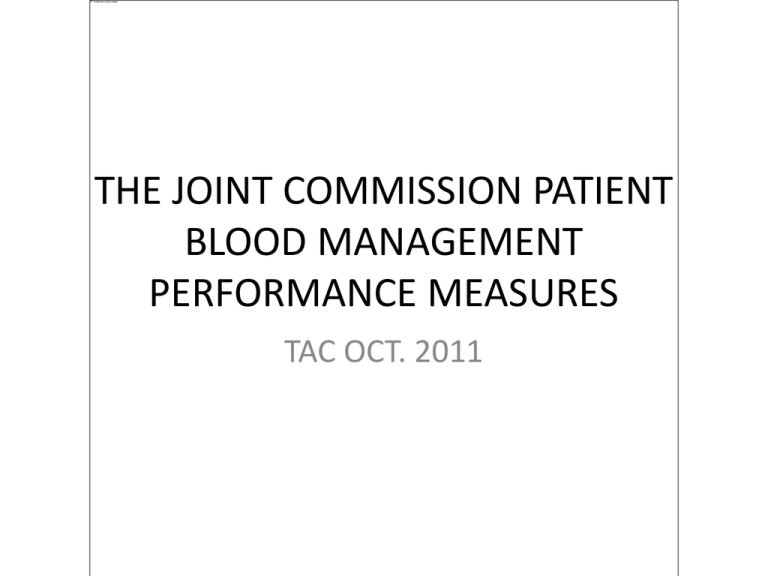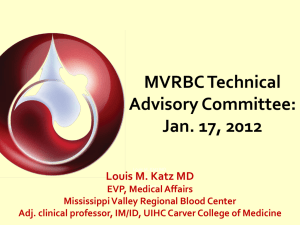the joint commission patient blood management performance
advertisement

THE JOINT COMMISSION PATIENT BLOOD MANAGEMENT PERFORMANCE MEASURES TAC OCT. 2011 PBM-NQF • Although not endorsed for use at the national level by NQF at present, these measures are an excellent tool for healthcare organizations to evaluate the transfusion consent process, blood utilization, blood administration documentation and identify processes related to elective surgery that may decrease the need for blood and improve patient safety. PBM-01 • Transfusion Consent – Patients with a signed consent who received information about the risks, benefits and alternatives prior to the initial blood transfusion or the initial transfusion was deemed a medical emergency Transfusion Consent Rationale PBM-01 • The rate of transfusion consent in US is unknown • Studies in other countries show that there is poor documentation and room for improvement • Involving patients in healthcare decisions is a national priority Feedback on PBM-01 • Hospitals support this measure because information about transfusion is not consistently given to patients • Information is provided by a variety of staff • Staff need education about the risks, benefits and alternatives • Informed consent for blood transfusions is not required by all states • Consent process varies between hospitals PBM-02 • RBC Transfusion Indication – RBC units transfused with pre-transfusion hemoglobin or hematocrit result and clinical indication documented. RBC Transfusion Indication Rationale PBM-02 • Information about total blood use could be used to determine benchmarks by diagnoses or procedure • Promotes a standardized process of – Checking a lab result prior to each transfusion – Documentation of a reason why blood was transfused Feedback on PBM-02 • Hospitals have different “acceptable” pre-transfusion lab values • Difficult to identify transfusions during surgery • Point of care testing not used in all hospitals during surgery Feedback on PBM-02, con’t • Difficult to determine if documentation of clinical indication was sufficient • No standardized definition used for “bleeding” • Lack of national guidelines such as pretransfusion lab results not being required prior to transfusion. PBM-03 • Plasma Transfusion Indication – Plasma units with pre-transfusion laboratory testing and clinical indication documented. Plasma Transfusion Indication Rationale PBM-03 • No standardized method for hospitals to determine which patients should receive plasma • Promotes a standardized process of: – Checking a lab result prior to transfusion – Documentation of a reason why plasma was transfused Feedback on PBM-03 • Reasons for giving plasma are unclear and conflicting at times • An INR >2 and “bleeding” should be the only clinical indication PBM-04 • Platelet Transfusion Indication – Platelet doses transfused with pre-transfusion platelet testing and clinical indication documented. Platelet Transfusion Indication Rationale PBM-04 • There is no standardized method for hospitals to determine which patients receive platelets • Transfusion of platelets associated with adverse events • Promote a standardized process of – Checking a lab result prior to transfusion – Documentation of a reason why platelets were transfused Feedback on PBM-04 • There is concern that establishing a critical value would trigger increased platelet use • Hospitals are unclear about: – Whether platelets are indicated when patients on Plavix – The definition of ‘thrombocytopenia’ PBM-05 • Blood Administration Documentation – Transfusions of blood units with documentation for all of the following: • Patient identification, transfusion order and blood ID number confirmed prior to the initiation of transfusion. • Date and time of transfusion. • Blood pressure, pulse and temperature recorded pre, during and post transfusion. Blood Administration Documentation Rationale PBM-05 • Transfusion process is very complex and has been identified as a high-risk area for error • Standardizing the process will enable reliable tracking of potential adverse events nationally • Numerous errors are associated with incorrect patient ID • Administration data elements – Patient ID verification, Tx order, Tx start date, Tx start time, Vital sign monitoring, Blood ID number Feedback on PBM-05 • Some data elements are difficult to collect when blood products are transfused during surgery • The data element criteria are standards of care and already being collected • “Transfusion orders” are usually not required during surgery. PBM-06 • Preoperative Anemia Screening – Patients have documentation of preoperative anemia screening 14-45 days before Anesthesia Start Date Preoperative Anemia Screening Rationale PBM-06 • Preoperative anemia is associated with increased morbidity and mortality • National audit found that 35% of patients scheduled for joint replacement therapy had a hgb <13 at preadmission testing. • Formal protocols for early detection, eval and management of high-blood loss surgeries has been identified as an unmet need. Feedback on PBM-06 • Information is not done or not available • One barrier is who will manage care prior to surgery • Information about when the patient was scheduled for surgery was not always in the medical record • Consider adding another measure to evaluate if anemia screening was effective PBM-07 • Preoperative Blood Type and Antibody Testing – Patients with documentation of preoperative type and screen or type and crossmatch completed prior to Anesthesia Start Time. Preoperative Blood Type & Screening Rationale PBM-07 • This measure is supported by TJC National Patient Safety Goals • Patient safety is a national priority • This issue affects the majority of hospitals and other high-blood use procedures Feedback on PBM-07 • This is a patient safety issue • Hospitals should document whether blood is available on pre-procedure checklist • Some hospitals would like to see this measure be required and completed sooner than anesthesia start time • Type and Screening NOT completed prior to surgery happens frequently Next Steps for PBM Measures • Encourage use of the PBM measures at the local level • HHS is organizing further data collection efforts • The seven blood measures have been added to the measure reserve library. They can be used as non-core measures until they are called upon for national use. Historically, this occurs in alignment with CMS • Funding pending for retooling the specifications for retrieval in electronic medical record Appropriate Inventory Management • AIM Module I – 19 blood centers have completely implemented (~400 hospitals participating) • AIM Module I version 1.1-Hospital ADL – Allows the participating hospitals to provide electronic files to automate their Module I data input • 11hospitals participating using ADL 17 AIM-Module 1 • Create a community approach to blood management to ensure patient transfusion needs are met • Determine how many days worth of inventory are needed based on many criteria • Benchmark and trend community inventories against hospital usages using a national database Transparency Provides Trust – A Partnership Leukoreduced Red Cells : Detailed Graphical Display Hospital name: DePaul Health Center Graph type: Days Worth of Inventory Blood group: All Blood Groups Cluster: All selected categories - RBC Usage - Very High Cluster count: 10 Hospital Average Cluster Average Standard Deviation Hospital Days Jul 2010 4.68 7.11 2.84 4 6.92 Aug 2010 4.68 7.11 2.82 4 7.13 Sep 2010 4.68 7.11 2.48 4 7.12 Oct 2010 4.68 7.11 2.18 5 7.39 Nov 2010 4.68 7.11 2.64 5 7.35 Dec 2010 4.68 7.11 2.96 6 7.84 Jan 2011 4.68 7.11 2.95 5 7.2 Feb 2011 4.68 7.11 3.85 6 7.37 Cluster Days Hospital name: DePaul Health Center Graph type: Wastage as a Percentage of Distributed Blood group: All Blood Groups Cluster: All selected categories - RBC Usage Very High Cluster count: 23 Hospital Percentage Cluster Percentage Hospital Average Cluster Average Standard Deviation Jul 2010 1.1 0.45 0.34 0.34 1.46 Aug 2010 0 0.37 0.34 0.34 1.71 Sep 2010 0 0.31 0.34 0.34 0.99 Oct 2010 0.23 0.32 0.34 0.34 1.23 Nov 2010 0.41 0.32 0.34 0.34 1.01 Dec 2010 0.52 0.57 0.34 0.34 2.32 Jan 2011 0.23 0.24 0.34 0.34 0.82 Feb 2011 0 0.16 0.34 0.34 0.58 Leukoreduced Red Cells : Detailed Graphical Display Hospital name: DePaul Health Center Graph type: Wastage as a Percentage of Distributed Blood group: All Blood Groups Cluster: All selected categories - RBC Usage - Very High Cluster count: 23 Improper Communication Improper Handling Breakage/Bag Integrity Patient Not Ready Cancelled Order Patient Expired Equipment Failure Failed Visual Inspection Outdated Jul 2010 0 0 0.27 0 0.27 0 0.55 0 0 Aug 2010 0 0 0 0 0 0 0 0 0 Sep 2010 0 0 0 0 0 0 0 0 0 Oct 2010 0 0.23 0 0 0 0 0 0 0 Nov 2010 0.20 0 0 0.20 0 0 0 0 0 Dec 2010 0 0.52 0 0 0 0 0 0 0 Jan 2011 0 0.23 0 0 0 0 0 0 0 Feb 2011 0 0 0 0 0 0 0 0 0 Average 0.02 0.17 0.03 0.02 0.03 0 0.06 0 0 Cluster 0.01 0.05 0.01 0.01 0.00 0.00 0.00 0.26 0 Leukoreduced Red Cells : Detailed Graphical Display Hospital name: DePaul Health Center Graph type: Inventory Age at Receipt Blood group: All Blood Groups Cluster: All selected categories - RBC Usage - Very High Cluster count: 23 Leukoreduced Red Cells : Detailed Graphical Display Hospital name: DePaul Health Center Graph type: Transfusions as a Percentage of Received Blood group: All Blood Groups Cluster: All selected categories - RBC Usage - Very High Cluster count: 8 Hospital Percentage Cluster Percentage Hospital Average Cluster Average Standard Deviation Jul 2010 89.32 89.22 94.84 91.41 33.97 Aug 2010 93.16 82.37 94.84 91.41 16.88 Sep 2010 96.5 99.14 94.84 91.41 6.86 Oct 2010 92.34 95.45 94.84 91.41 7.9 Nov 2010 96.31 90.78 94.84 91.41 8.42 Dec 2010 90.65 88.38 94.84 91.41 11.86 Jan 2011 93.35 90.88 94.84 91.41 7.27 Feb 2011 107.09 97.71 94.84 91.41 8.41 AIM Hospital Community • Potential to have thousands of hospitals of all sizes and services providing data to a true national data base accessible to all participating hospitals – User group of hospital transfusion committee members discussing findings and seeking best practices – AIM uses the established blood utilization review mechanism without the need for additional staff 38 Summary • The PBM measures are general measures that collect data on all patients that can be further analyzed by diagnoses and/or procedure code, age group or appropriateness as studies become available • The abstraction burden for PBM measures using paper based records is labor intensive and would capture only a percentage of the transfusions • The lack of national guidelines for blood impacts the ability to standardize clinical indications Summary • AIM provides blood centers a tool to assist hospitals and physicians to better manage and use the available blood supply while: – Lowering the risk of transfusion complications – Lowering the cost of blood, and – Maintaining appropriate inventory levels to ensure patient transfusion support 39 Resources • http://www.jointcommission.org/patient_blood_ management_performance_measures_project/ • Expectations From The Joint Commission, Jennifer Rhamy MBA, MA, MTTT(ASCP), HP Executive Director • Patient Blood Management Performance Measure Project, Harriet Gammon, MSN, RN, CPHQ • AIM (Appropriate Inventory Management), Kellie Kerr, America’s Blood Centers, Carrie Hantack, MVRBC







